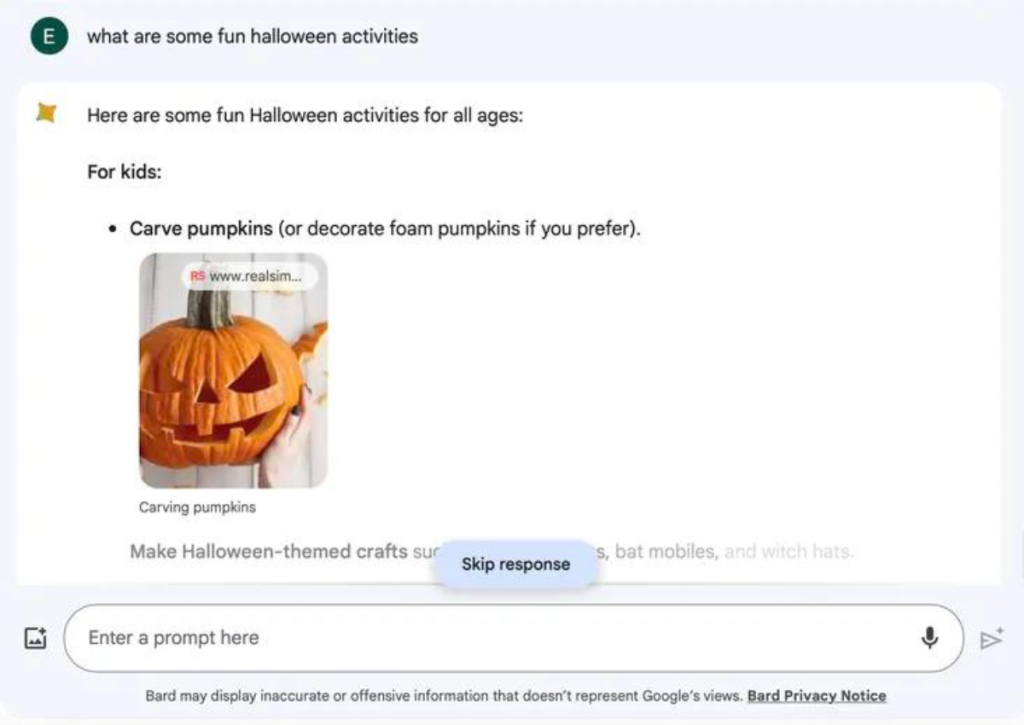
Google’s Bard AI chatbot has taken a significant leap forward in its conversational capabilities. Previously, it would respond to your questions only when it had completed generating a reply. However, Google has now empowered its chatbot to respond in real-time, offering users a glimpse of their answer as it’s being generated.
Real-Time Responses: A New Level of Interactivity
This newfound feature allows for a more dynamic and interactive chatbot experience. When you ask a question, you no longer need to wait for chatbot to finish formulating its response. Instead, you can witness the chatbot’s thought process in action. This real-time interaction adds a layer of transparency and immediacy to the conversation, making it feel more like a human exchange.
Choose Your Chatbot’s Tempo
But what if you prefer the old way? Google has you covered. You can easily toggle between the “Respond in real time” and “Respond when complete” options from the cog icon located in the top-right corner of Bard’s chat window. This gives users the flexibility to choose the response style that suits their needs.
Microsoft’s Bing Chat Joins the Real-Time Conversation

Google’s main competitor, Microsoft, is not far behind in this real-time chatbot game. Bing Chat, Microsoft’s AI chatbot, also offers real-time responses, highlighting the growing trend in AI chatbot development.
Silencing Bard Mid-Sentence: User Empowerment
One standout feature that Google has introduced with it’s chatbot real-time capabilities is the ability to halt the chatbot mid-sentence. If it starts generating a response that you find unhelpful or off-topic, a “Skip response” button will appear above the prompt box.

By pressing this button, you can interrupt it’s response and proceed to ask a different question or request a new response, all without having to wait for the entire answer. This feature empowers users to maintain control over their conversations with the AI, ensuring that interactions remain efficient and relevant.
Exploring Alternate Responses and Customization
Should you choose to wait for it’s answer, Google provides an additional feature called “view other drafts.” This enables users to explore alternate responses that google chatbot might have generated for the same question. You can even modify the response to suit the tone you prefer, whether it’s a casual or professional style. This level of customization allows for a more personalized and human-like interaction with the chatbot.
Verifying Responses with Google Search
Google has gone a step further in enhancing chatbot’s capabilities by allowing you to cross-reference its answers with information from Google Search.

By clicking the Google logo in the bottom menu bar, you can verify the accuracy and relevance of chatbot’s responses, ensuring that the information provided is up to your standards.
You Might be like to Read Some More Tech Relatsed Articals: Technology 2023: Uncovering the Next Big Things
Additional Features and Gmail Integration
In addition to these exciting updates, Google has introduced several other enhancements to AI chatbot. Users can now view uploaded images in shared conversations, making it easier to share and discuss visual content. chatbot’s integration with Gmail has also seen improvements.

The chatbot can now summarize multiple emails simultaneously, streamlining the process of managing your inbox. Moreover, Google claims that chatbot has a heightened understanding of when you need to access the latest emails, improving the chatbot’s overall utility in email management.
Conclusion: The Evolution of AI Chatbots
Google’s chatbot has come a long way in offering users a more natural and responsive conversational experience. The introduction of real-time responses, the ability to skip unhelpful replies, and features for customization and verification make it a formidable tool for various tasks. As AI chatbots continue to evolve, Google’s chatbot sets a notable example of how they can adapt to user preferences and provide more intuitive interactions.

Google’s AI chatbot is not only catching up to real-time conversation expectations but also setting new standards for chatbot flexibility and customization. These improvements signify the continued evolution of AI chatbots toward more human-like, user-friendly interactions.

